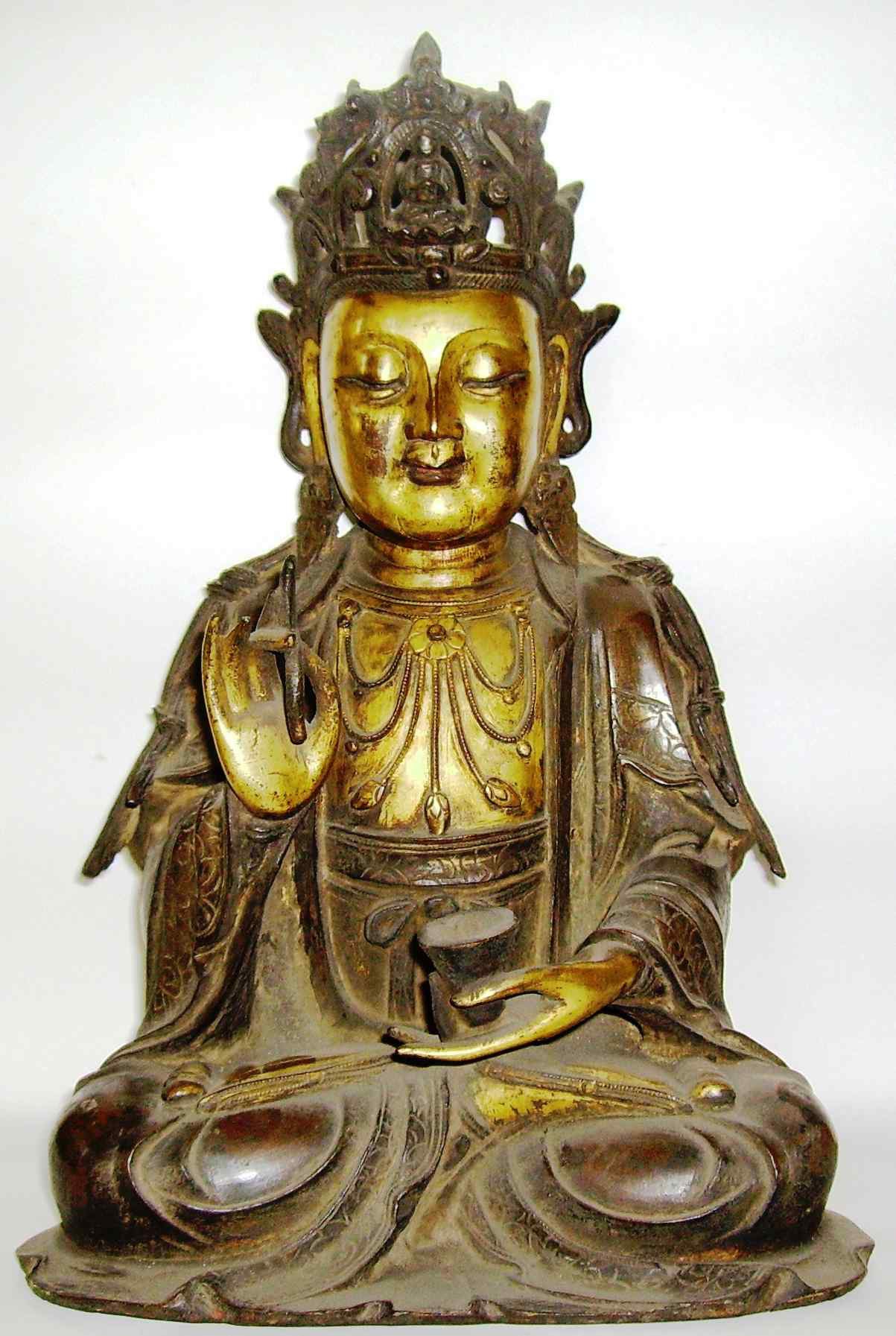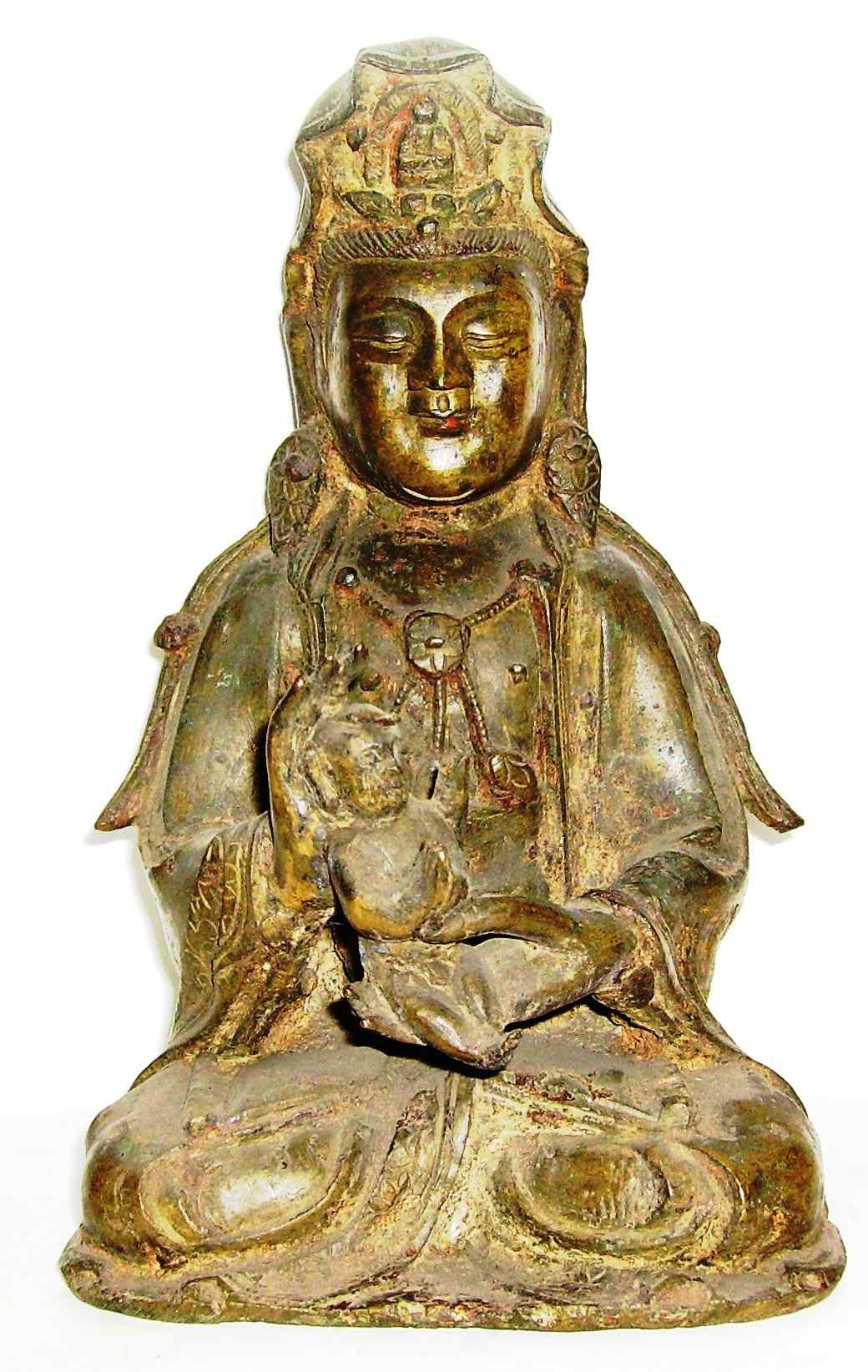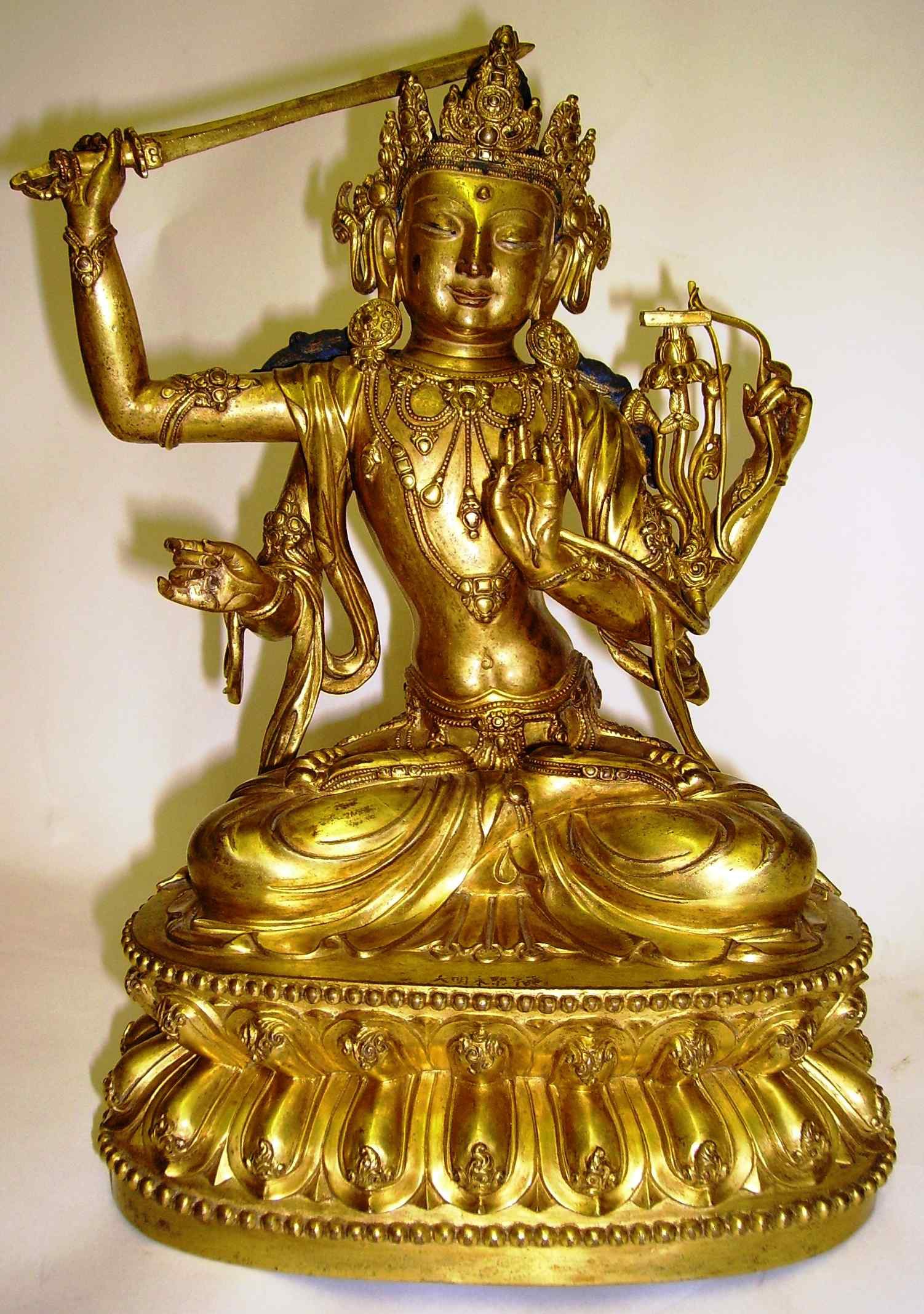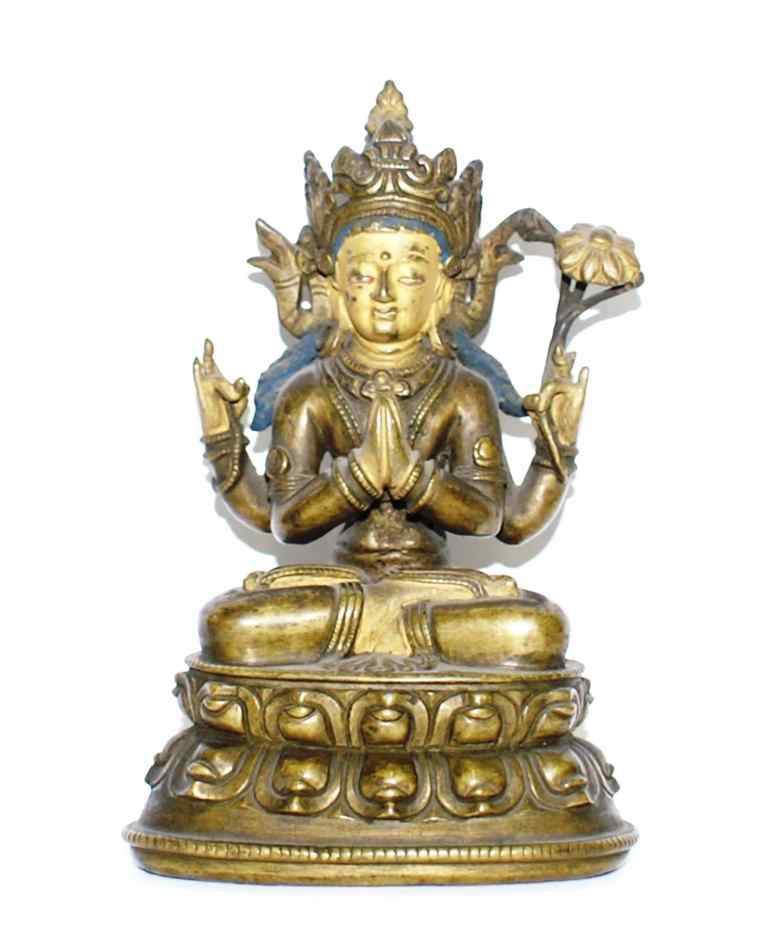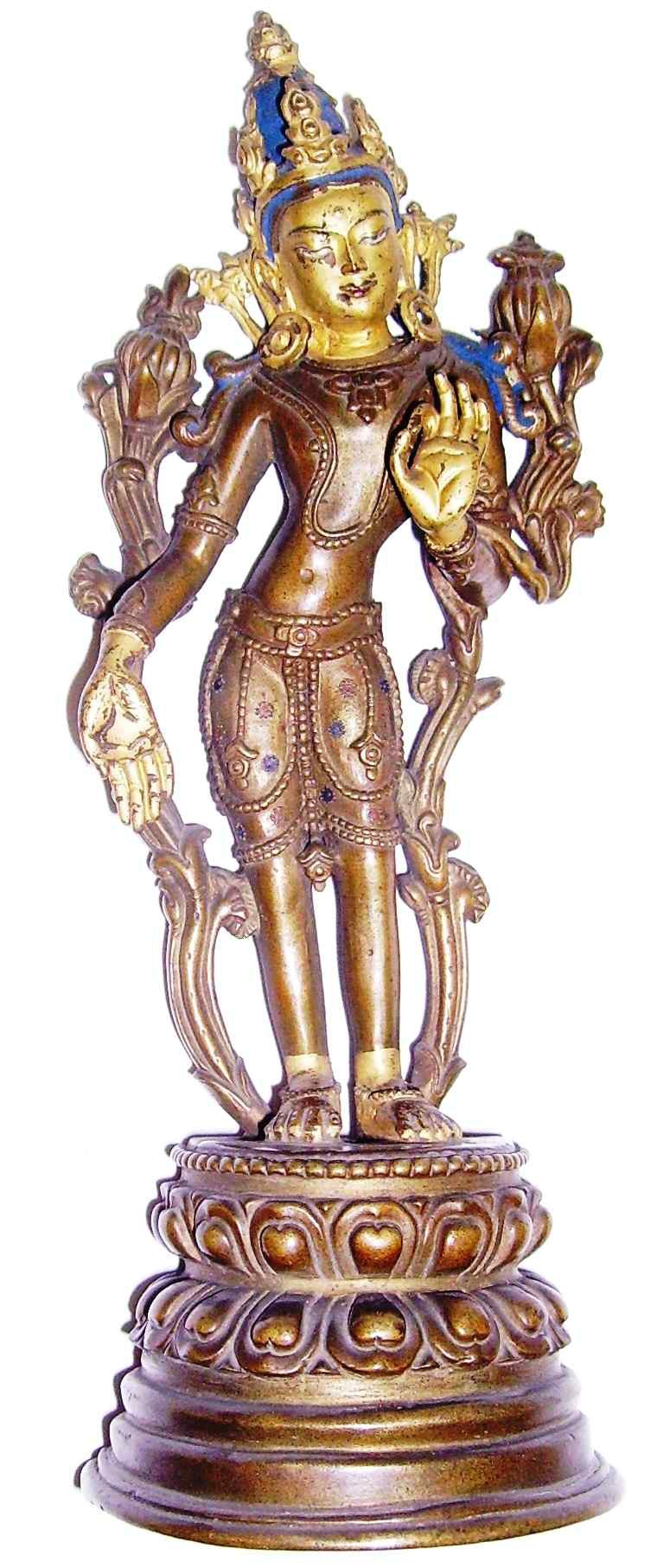


The central concepts of Buddhism are the achievements of enlightenment and the clearing of suffering. The ideal of the bodhisattva ‘great compassion’ is fixed as the major idea of the Mahayana. This ideal became the most popular in Buddhist Asia. In such an interpretation bodhisattvas are on a higher level than that of Buddha in that they help to rescue to all living beings.
It is considered, that from the period from 1st to 2nd centuries CE two basic directions―the Hinayana (the Small chariot) and the Mahayana (the Great chariot) have appeared in Buddhism.
The pilgrim Yijing (635-713) who visited Nalanda, in India, in the 7th century, has underlined in the diary, that the life of monks of these two directions practically had no differences: they followed principles of Vinaya (disciplinary codices for monks), carried monastic clothes, asked for alms and worshiped the Three Jewels. The difference consisted only in the worship practice to bodhisattvas and reading Mahayanistic sutras.
The Mahayana has strongly facilitated and has simplified a way to rescue all beings, having made it accessible not only for monks, but also for laymen. In the Hinayana traditions some schools played a large role in formation and distribution of Buddhism. Two schools, Sarvastivada and Sammatiya, were especially popular. One of the branches, Mahasanghika is Lokottaravada (the large initial text
In the opinion of Lokottaravada, bodhisattvas, the higher beings spiritually progress at seven levels (bhumi), travelling to various worlds, where they listen to teachings of the Buddha how to help all terrestrial beings to be rescued from the cycle of reincarnation.
There are three types of bodhisattva. Bodhisattvas of the first type consider that for the sake of rescuing of all living beings, it is necessary to be improved until the full achievement of nirvana. Becoming a being of nirvana nature and possessing divine wisdom, it is possible to rescue most effectively all living beings of samsara. Bodhisattvas the second types are thought to be embodiments of bodhi and are similar to a boatman. They consider that they should reach nirvana together with all other beings in samsara, like a boatman reaching the other shore along with all beings. The third type bodhisattvas are thought to be embodiments of bodhi, similar to a shepherd. These bodhisattvas should leave samsara the last, like the shepherd who has a rest only after driving out the herd (Дандарон 1973, 464).
At the beginning of a new era of the second direction of Buddhism– the Mahayana–starts to be formed and developed. Mahayana Buddhism is guided by an attraction of many followers in all layers of society without the necessity of acceptance of monastic vows. The treatment of Lokottaravada promoted the concept of the occurrence of “Three bodies of the Buddha”: Dharmakaya (the Absolute body), Sambhogakaya (the Pleasure body) and Nirmanakaya (the Shown body). The historical person‒Buddha Sakyamuni‒acted for Mahayana adherents as the terrestrial personification of a bodhisattva. In a direct connection with such an interpretation is the Mahayana doctrine about bodhisattvas (Hirakawa 1990, 259). The main difference of the doctrine of the Mahayana from early Buddhism consists of the doctrines about bodhisattvas, prajna-paramita and Buddhas. In early Buddhism and compositions of Hinayana, Buddha Sakyamuni before his enlightenment was named a bodhisattva, including all his previous births.
II. Indian Roots of Main Cults of Bodhisattva
The cult of Avalokitesvara appeared in northern or northwestern India in approximately the 2nd century CE. It is mentioned in various compositions such as
There are different Buddhist legends about the origin of Avalokitesvara: in one he appeared from a white beam of light which starts at the left eye of Buddha Amitabha, in another he was born as a sixteen year old young man from a lotus flower. There is also one more legend about birth of Avalokitesvara in the pure land of Sukhavati. By the end of the 6th century in India Avalokitesvara definitively gets the status of an independent deity: he has a retinue of bodhisattvas, and is resorted to for help in certain vital situations: he helps to prevent various dangers, cures illnesses, and renders compassion. The first image of eleven-headed Avalokitesvara is dated at the end the 5th―the beginning of the 6th centuries. This form occurs in Kankheri (a cave no. 41). The forms Avalokitesvara with many arms are typical for Tantric of art which occur in northeast India after the Gupta dynasty.
The cult of Manjusri, bodhisattva of wisdom, appeared in India in the first century CE. In popularity this cult is second only to the cult of Avalokitesvara. The composition of “Manjusri-mulakalpa” is devoted to Manjusri. In this text he is in the center of all doctrinal discussions. He asks various questions to Buddha Sakyamuni on the treatment of positions of the doctrine. His name is often mentioned in compositions such as:
There are different opinions on the origin of the cult of Manjusri. According to one he belonged to a Brahman family, living near to the city of Shravasti. Before achievement of nirvana he compiled initial Buddhist compositions. He was esteemed along with such outstanding teachers as Nagarjuna, Aryadeva and Asanga, which in his life time Xuanzang named as bodhisattvas (Bhattacharya 1968, 101‒2; Soper 1956, 220). According to another opinion Manjusri is an emanation of Buddha Amitabha or Akshobhya.
The cult of the bodhisattva Vajrapani appears in India in last centuries BCE. In Hinayana texts he is presented as part of the retinue of Buddha Sakyamuni. In the tradition of Mahayana Vajrapani is an emanation of Buddha Akshobhya and Dhyani-bodhisattvas. His female companion is Locana.
The attribute of Vajrapani is the diamond scepter of Indra the Thunderer, the Vedic god. This scepter is called a ‘vajra.’ Some researchers consider, that Vajrapani who otherwise may be Indra or Shakra from Brahmanic tradition (Grünwedel 1900, 38). It is well known, that Buddhism adapted many local deities, including them in their pantheon.
Though Vajrapani does not enter into three lists
Xuanzang in the travelling notes underlined, that Vajrapani was present in the retinue of Buddha Sakyamuni when he pacified snakes in Uddiyana. Snakes gathered in a large quantity to listen to the sermon of the Buddha. He entrusted Vajrapani to preserve snakes against attack from the Garuda. Vajrapani with the vajra weapon always acts as the constant companion of the Buddha for protection against any enemies (Banerjee 1994, 31).
The cult of Maitreya, the Future Buddha, was widespred. One of the earliest Sanskrit texts
III. The Cult of Avalokitesvara in Tibet in the 7-8th Century
Buddhism gets into Tibet rather late in the 7th century, and gains prominence. The central figure in the Tibetan history is the king Songtsen Gampo (613‒49)―the founder of the unified state. He accepted Buddhism himself and started to extend the doctrine. The Tibetan alphabet was created on his order, and he established the first Tibetan laws. There are different points of view in the works of European scholars about the distribution of Buddhism in the time of Songtsen Gampo. Some of them have considered that Buddhism had no such successes which were attributed by later compositions.
According to the later Buddhist sources it is considered, that cult of Avalokitesvara had spread into Tibet with the first wave of distribution of the doctrine, i.e. in the time of Songtsen Gampo. This king himself is esteemed as one of terrestrial reincarnations of Avalokitesvara. In the
IV. Cults of Bodhisattva in the Three Kingdom and Unified Silla Periods
In Korea Buddhism appears in the end of the 4th century from China, (58 BCE‒668 CE) of Goguryeo (37 BCE‒668 CE) in the north; Baekje (18 BCE‒668 CE) in the south-west; and Silla (57‒668 CE) in the southeast and Gaya (42‒562 CE), a small federation nestled between Baekje and Silla. The traditional dates for the introduction of Buddhism are 372 for Goguryeo, 384 for Baekje and 528 for Silla (4th‒6th centuries).
The first images of bodhisattvas appeared in wall paintings from Jangcheon-ri Tomb no. 1, Goguryeo, at the end of the 5th century. Two sets of four standing bodhisattva images are painted on the surface of the northern and the southern part of the ceiling (Kim 2007, 15‒16). In the 7th century in Korea there were already many bodhisattva images, some of them were unidentified, as well as images of Avalokitesvara and Maitreya. This Seosan triad reflects a new phase of sculptural style. One can see Buddha with the retinue of Avalokitesvara (his attribute is a jewel of cintamani in both hands) and Maitreya in the form of a ‘contemplative bodhisattva.’ A sculpture with the same features is in the collection of the Hermitage Museum. Standing Avalokitesvara (40 cm) is represented with the small image of Buddha Amitabha in his crown, his attribute is cintamani, which he is holding in both hand. The ribbon in the lower part of statue was broken. This is Baekje iconografic feature (Fig. 1).
The theme of terrestrial reincarnations of different bodhisattvas is very interesting for me. I know of only one example from Korean history. The famous general Kim Yu-sin (595-673) was himself hwarang and played a key role in Silla’s unification of the Three Kingdoms. He is considered as the terrestrial reincarnation of Maitreya (Kim 2007, 53‒54).
The Samhwaryeong Buddha triad was discovered near Mt. Namsan. This group demonstrates the new iconography style. There is an image Maitreya in the form of the Buddha sitting in the European pose (bhadrasana), later this form will once again repeat during an epoch to the Goryeo.
In the period of the Three Kingdoms images of bodhisattvas were wide-spread. They appeared in mural paintings, in bronze and in stone. Most popular were the cults of Avalokitesvara and Maitreya. There were also many images of unidentified bodhisattvas, especially in triads.
In Korea during the period of the Unified Silla Dynasty bodhisattva Mahasthamaprapta appeared in the retinue of Buddha Amitabha along with Avalokitesvara. Such images had not received distribution in the art of Tibet. There are images of Avalokitesvara with four arms, eleven-headed with two arms in Seokguram, and eleven-headed with six arms. There is also the image of Maitreya as a bodhisattva. Maitreya is the unique deity of the Buddhist pantheon who can be represented both as a Buddha and as a bodhisattva. However in Korea, similar images of bodhisattva Maitreya were not widespread.
In the period of Unified Silla there were cults of different bodhisattvas such as: Avalokitesvara, Manjusri, Mahasthamaprapta, Samantabhadra and unidentified ones. Avalokitesvara is depicted in varied forms such as eleven-headed with two arms, eleven-headed with six arms, one head with four arms and the usual form. Many hands and heads in the image of the deity are elements of esoteric Buddhism in the Unified Silla period, during which the masters followed the style of the Tang dynasty.
V. The Cults of Bodhisattvas in Tibet
One more king, Trisong Detsen, was esteemed as a terrestrial reincarnation of the bodhisattva Manjusri. In 945, in Tibet, King Ralpachen who preached the doctrine of the Buddha had been killed. He was esteemed as a terrestrial reincarnation of the bodhisattva Vajrapani. One change came about in the person of King Langdarma, an ardent opponent of the Buddhism. Prior to the beginning of the 10th century Buddhism existed only in the territory of the western Tibet. Then Buddhism began its revival, monasteries were constructed, and many sculptures and paintings were produced. Two rare products concern the Western Tibetan art: bodhisattva and Maitreya.
Sculptures presented to the Hermitage collections from the 11th–12th centuries with the image of bodhisattvas Avalokitesvara and Manjusri, and the Indian samples from the 11th century and the Tibetan copy of the Indian sculpture.
According to Buddhist tradition, Bodhisattva Avalokitesvara had been directed to Tibet by the Buddha. The statement, that the Land of Snows is the special residence of Avalokitesvara, is fixed in the Tibetan text
In Tibet at this time there are two schools of gilded and non-gilded bronze. In the Hermitage collection there are various images of bodhisattvas. In the 12th century the spread of the cult Avalokitesvara publicly had begun, and in second half the 13th century under the second leader, or Karmapa, of the Karma-kagyu School, Karma Pakshi (1204‒83), had developed the ritual connected with this cult. As the tradition of this school in the 13th century the institute of terrestrial reincarnation of bodhisattva Avalokitesvara was generated (the tulku system), and Karma Pakshi declared himself as a reincarnation of this deity. At the age of eleven he received the mystical doctrine from Mahasiddha Tilopa (988-1069), the line founder of karma-kagyu school, and in his spiritual vision understood that he was a terrestrial reincarnation of eleven-headed Avalokitesvara with eight arms. Such an image of the bodhisattva Avalokitesvara is presented in the collection of the State Hermitage. Later, all Dalai-lamas began to be considered as the terrestrial reincarnation of bodhisattva Avalokitesvara as well, but in another form.
VI. The Cults of Bodhisattvas during the Goryeo Period
During the Goryeo period images of Avalokitesvara, Ksitigarbha, Mahasthamaprapta, eight bodhisattvas from retinue of Buddha Amitabha became most popular. In the retinue of Buddha Shakyamuni appeared bodhisattvas of Samantabhadra and Manjusri. Avalokitesvara is often represented sitting in the royal ease pose. This pose shows his superiority not only over spiritual, but also over the secular and a material world. At this time Tibetan art shows its influence on the art of Korea.
Other bodhisattvas are depicted in the retinue of Buddha Amitabha in the Goryeo period, there are Eight Bodhisattvas described in The Mandala Sutra. The Sutra is a Buddhist sacred text, and a mandala is a magic diagram. Korean paintings of Amitabha and the eight bodhisattvas first appeared in the late Goryeo dynasty. 1. Avalokitesvara, and 2. Mahasthamaprapta are two usual attendants of Amitabha, 3. Samantabhadra, bodhisattva of wisdom, holding a scepter (ju’i), 4. Manjusri, another bodhisattva of wisdom, holding a stalk of lotus supporting a book, 5. Ksitigarbha, his implements are a monk’s staff and a flaming jewel, 6. Bodhisattva Maitreya (Forthcoming Buddha), he is often paired with Ksitigarbha, his hands in dharmacakra-mudra, and two little-known Tantric bodhisattvas, are Vajragarbha and Vijnesvara, each holding a sword.
Tibetan art became international as it extended through the different people who were practicing Tibetan Buddhism: Chinese, Nepalese, Tanguts, Mongols, the Buryat, Kalmyks, Tuvans, and Bhutanese as well as inhabitants of Sikkim, Mustang and Ladakh.
VII. The Cult of Avalokitesvara in China
Buddhism spreads to China in the 1st century CE and historical chronicles describe the existence of three Buddhist communities in the territory of China. Buddhism extended to China through territory of Eastern Turkestan through which there passed the Silk roads and where there were many Buddhist centers and monasteries. There were also many Buddhist compositions which have been translated into the Chinese language. Among early Buddhist monuments at first the image of Buddha Sakyamuni was the most widespread, then in his retinue appear bodhisattvas, at first not personified, and then easily recognized. The sculpture in China was made of stone, reliefs cut down in caves from rocks, cast from bronze, molded from clay, cut from wood and ivory and molded of porcelain. The Chinese artists decorated walls of caves, temples, painted scrolls on silk by various Buddhist plots.
The process of the transformation of Buddhism in China, maybe, is most distinctly traced in those changes which were undergone by the image of the bodhisattva Avalokitesvara on Chinese soil. In the process of Mahayana’s distribution in China the preaching of the cult of bodhisattvas, saviors of all live beings, Avalokitesvara takes a more and more significant place in a pantheon of Chinese Buddhism and Avalokitesvara gains the status of the most popular deity. In
Avalokitesvara becomes the most esteemed deity after Buddha Amitabha during the period of the Tang dynasty (618-906). He is represented with a lotus and a vessel (kundika).
In China such compositions as:
In early Chinese sutras there are no descriptions of Avalokitesvara, some of them speak about his different forms.
In the Chinese version
The eleven-headed bodhisattva has appeared in China in
In China the apocryphal texts devoted to Avalokitesvara were extended. Some of the Chinese empresses had meditative dialogues with the bodhisattva which were described in apocryphal stories, and one of them, mother of emperor Wanli (r. 1573-1620) Ming dynasty, the a widow empress, Li was esteemed as a terrestrial reincarnation of Guanin. This tradition, most likely, goes back to legendary princess Mjaoshan who was considered as the reincarnation of Avalokitesvara with one thousand hands and one thousand eyes. The first story about Myaoshan, engraving on the stone stele, is dated 1100.
According to the Chinese tradition there is the legend about her appearance from
Chinese sutras describe more often monks as terrestrial reincarnations of bodhisattva Guanin. One of the last empresses of the Sui dynasty (581-617) became the nun in 617 and has received name “Guanin.” The name Guanin, approximately since the 5th century, gained popularity in China.
Some Chinese monks also were considered as terrestrial reincarnations of eleven-headed Avalokitesvara. They were Baochji (425-514) and Sentsze (d. 710). Baochji was esteemed as a holy monk and was represented as twelve-headed Avalokitesvara: an eleven-headed bodhisattva and the person of the monk. Sentsze was also esteemed as a deity and as an emanation of eleven-headed Avalokitesvara. He is represented with a vessel-kundika or a willow branch, implements of Avalokitesvara (Yű 2001, 202‒14).
The governor of princedom Uyue (Northern Song Dynasty; 978), Qiang-shu, ordered many images of twelve-headed Avalokitesvara (Yű 2001, 228).
In the Tang period Avalokitesvara is esteemed only as a male deity, but in days of early the Song there is a female image of Guanin. Such full transformation ended during the Yuan dynasty (1279‒1368). Since the Ming dynasty (1368‒1644) Avalokitesvara is esteemed in both male and in female images. During the Ming dynasty there were images of five, thirty two and thirty three forms of Guanin. In
In the Song period one more form of the bodhisattva, so-called ‘Water-Moon’ was added. Guanin is represented as a male deity with a vessel and a willow branch. ‘Water-moon’ is the one of ten Chinese metaphors showing the illusion of the world.
In China the image of Guanin in ‘water-moon’ form was placed on the back mirrors. Resembling this form, there appears another image of Guanin‒‘The white robes’ (Yű 2001, 249). It is considered, that this form of the deity is borrowed from Tibet where she was esteemed as Pandaravasini, ‘dressed in white,’ one of the forms of White Tara, the goddess of longevity, companion of Avalokitesvara. In the Tibetan tradition Pandaravasini is prajnya, the female consort, the companion of Buddha Amitabha (Saletore 1987, 3:1107‒8).
Probably, the female cult of Guanin was imposed from an ancient universal cult of the Goddess-mother (Yű 2001, 411‒12).
In the literature there is also another opinion that cult of Guanin is connected with the Chinese goddess of the sea Shenmu (Sheng mu). In one of her forms Guanin is the patroness of fishermen (Banerjee 1994, 55).
In China thirty three iconographical forms of Avalokitesvara are most popular. L. Chandra in detail sorts the iconography of Avalokitesvara with one thousand arms. The first such image appeared in Tang dynasty (619‒29). The most widespread text devoted to the form Avalokitesvara with one thousand arms, has been translated into the Chinese language by Amoghavajra (704‒74) in 723. His composition is called
In China there is the pilgrimage place of the Mountain Pu-to. Actually, it is represented as a small island which is considered the residence of Avalokitesvara, some kind of Potala, and has been esteemed from the time of the 10th century (Yű 2001, 353).
Images of Avalokitesvara and Guanin, presented in the collections of the State Hermitage, are rather numerous. They are executed from bronze, stone, wood and porcelain, written on a paper, silk and canvas. We will consider the most typical images such as 1. Avalokitesvara sitting in a pose with crossed legs, wearing a crown with a small figure of Buddha Amitabha. In this form at he has eighteen arms. The basic hands are combined in gesture andjali-mudra. Implements are partially broken off, partially lost. In the top hands he holds a sword and an umbrella, in the right hands a lotus, beads, three types of ritual daggers, in his left a vessel, a lasso, chakra (the wheel of the Law), a bowl, a hand bell and a book.
2. Guanin sits in a pose with crossed legs. In her crown there is a small figure of Buddha Amitabha. In the right hand she holds a willow branch, in her left―there is a vessel (Fig. 2).
3. Guanin with the child; China, 18th century. Guanin sits in a pose with crossed legs. In her crown there is a small figure of Buddha Amitabha. In her two hands she holds a child (Fig. 3). Such porcelain images of Guanin received a wide circulation in China during the 18th century.
Thus, with the distribution of Buddhist doctrine the cult of Avalokitesvara gained special popularity in China. Here there is the transformation of an image of a deity from male to female, the cult becomes connected to the state, and princesses, empresses and nuns were considered as terrestrial reincarnations of the deity.
>
VIII. The Cult of the Bodhisattva Manjusri in China
In China the cult of the bodhisattva Manjusri was not less popular. According to legends honoring Manjusri ascend by the time of emperor Mindi. Mountain Utaishan (Wǔtái Shān), it is considered a sacred place of the bodhisattva wisdom, and one of four sacred mountains of China. According to
Of the Chinese legends Buddha Sakyamuni had charged Manjusri to preach the doctrine in China. It is believed that, Bodhisattva Manjusri often appears on the mountain, accepted as an appearance by pilgrims and monks are unusual five-color clouds. Such clouds are connected to Manjusri in that his forms can have different colors of body: orange, white, red, dark blue and green.
All Chinese emperors of Qing dynasty (1644‒1911) were esteemed as terrestrial reincarnations of Manjusri.
If the first millennium in China is the period of prosperity of Buddhism, then it is possible to consider the second millennium as the time of the triumph of Confucianism. Tibetan Buddhism was a considerable exception. Its distribution had begun with coming to power of the Mongolian Yuan dynasty. Unsurpassed masterpieces of the Chinese Buddhist art are bronze sculptures of the beginning of the Ming dynasty―emperors Youngle (1403‒24) (Fig. 4) and Xuande (1426-1435), executed in the Tibet-Chinese style, stored in the collection of the State Hermitage.
There is a remarkable example the image of Bodhisattva Manjusri in the form with four arms of Vajrananga Manjugosa. Bodhisattva Manjusri holds the basic implements in the upper hands: right‒a sword dissecting darkness of ignorance and in the left a stalk of the lotus on which there is the book
The Manchurian Qing dynasty also supported the dissemination of Tibetan Buddhism; especially blossoming Buddhism had reached its peak by the life time of the emperor Qianglung (r. 1736‒95).
The cult of Bodhisattva Manjusri in China had circulated widely and was considered the state cult by the Qing dynasty.
One more rather esteemed reincarnation of Manjusri is the line of the main court lama of Beijing.
The history of the appearance in Beijing of incarnations of the main court lama (Chjanchja-hutuhty) concerned the period of Manchurian emperor Kansi (1662‒1722) Qing dynasty. In 1680 Ngawang Lobsan Choiden (1642‒1714), the Tibetan monk from Gonlung monastery (Amdo region), had been appointed by the main court lama in Beijing. All Mongolian lamas received the permission to perform religious actions only from hands Beijing’s main lama. Emperor Yongzheng (1723‒35) confirmed a title and the power of the hierarch of following incarnation of Ngawang Lobsan Choiden, Rolpai Dorje (1717‒86). At the court of Qianglung he became the main adviser of the emperor concerning questions of policy and religion within Mongolia and Tibet.
Rolpai Dorje also organized the printing house and school of Tibetan painting in Beijing. Thus, by the activity of Rolpai Dorje Beijing had transformed into one of the largest centers of Tibetan Buddhism.
More often in painting and sculpture there are portrait images of the second Rolpai Dorje. On some of them he is represented mustached and with a small beard, on others smoothly shaved. Rolpai Dorje is usually presented in the traditional iconography. On his head is the monastic cap of the Gelukpa School. The right hand is located before his breast in the gesture of the vitarka-mudra; in it he holds a lotus stalk. In the left hand there is a vessel filled with the elixir of endless life. At the right shoulder the lotus on which the sword is located, at the left shoulder―a lotus with the book grows. These implements (a sword and the book) testify that Rolpai Dorje is considered a terrestrial reincarnation of the bodhisattva Manjusri. Such iconography of Rolpai Dorje is represented in the collection of images called “300 deities.” Rolpai Dorje is the author of this well-known iconographical composition. Various sculptural images of Rolpai Dorje are stored in the collection of the State Hermitage. On one of them Rolpai Dorje is depicted without a headdress. This image is portrait (Ольденбург 1903, 22; Lipton, Ragnubs 1996, 85; Rhie and Thurman 1991, 276) (Fig. 5).
Mass production of Buddhist sculpture concerns the period of the Qing dynasty. At this time different forms of bodhisattvas are presented such as Avalokitesvara, Manjusri, Vajrapani, Ksitigarbha and Maitreya.
The cult of Ksitigarbha was wide-spread in both China and Korea. Ksitigarbha, the bodhisattva of the earth womb, played a minor role in India, where from the 6th to the 12th century he was shown as one of a group of eight bodhisattvas, but not as an independent deity. Devotion to this bodhisattva, which began in Central Asia, can be traced back to the
Ksitigarbha (Dizang) is the bodhisattva of the Underworld, who vowed not to achieve Buddhahood until all hells are emptied. He is also a patron of travelers. This bodhisattva, who rescues the damned from Hell, is the savior of dead children in particular. He uses the iron monk’s staff in his right hand to batter down the gates of Hell and the flaming jewel in his left hand lights the way out of the underworld.
Ksitigarbha is the only bodhisattva depicted as a Buddhist monk. Other bodhisattvas wear the elaborate drapery and ornate jewelry an Indian prince, the imaginary garb of Prince Siddhartha (Buddha Sakyamuni before his enlightenment). Ksitigarbha wears the shaved head or close-cropped hair of monk.
The monk’s staff held by Ksitigarbha is like the actual staffs Buddhist monks used to carry while walking out-of-doors. Such a staff has loose jingle rings on its pineal; the sound they made was supposed to chase away insects in the monk’s path lest he step on one and break his vows against taking life.
X. Cults of Bodhisattvas in Tibet
There were eight main bodhisattvas in Tibetan tradition: Avalokitesvara (Fig. 6), Manjusri, Maitreya, Vajrapani, Ksitigarbha, Sarvanivaranaviskambhin, Akasagarbha and Samantabhadra. A lot of the Tibetan sculpture presented in the Hermitage collection is from the 13th to the beginning of the 20th century. These bodhisattvas have many deferent forms. Terrestrial reincarnations of bodhisattva Manjusri in the Tibetan tradition were Thonmi Sambhota, the king Trisong Detsen, Sakya-Pandita, Kunga Tashi, Sonam Lhundub and Tsongkapa.
Tsongkapa (1357―1419), the founder of the Gelukpa School, is esteemed as a reincarnation of the bodhisattva Manjusri (Fig. 7), and his pupils as reincarnations of Avalokitesvara (compassion) and Vajrapani (power). Thus, the triad symbolizes wisdom, compassion and power. It is possible to assume, that terrestrial reincarnations of bodhisattvas among monks and statesmen in the Tibetan tradition were much more numerous, I have mentioned only the most widely known. It is interesting; the Tibetan authors consider some lamas and statesmen as reincarnations of different bodhisattvas. Possibly, it is connected to the fact that Tibetans had spiritual practices and rituals of various deities.
XI. Korean Buddhist Art during the Joseon Dynasty
At the beginning of the Joseon period Chinese and Tibetan influences were strong. Later on the Korean style became dominant. The heads of deities seem large in proportions to the bodies, the necks are slightly bent, and the faces are round, frequently emotionless for the Korean style. A lot of wooden sculptures were made. The image of bodhisattva Manjusri as a child also appeared during this period. Such images can be seen only in Korea. The late Joseon images of bodhisattvas didn’t have personified features; their gestures were mostly vitarka and the gesture of worshipping. Images of pairs of bodhisattvas are usually symmetrically in attitude toward the central Buddha. Over all images became more simplified in the Korean style.
Cults of bodhisattvas are widespread in the countries where the people practice the Mahayana tradition. We can see different images and iconography, but they have the same main features such as peaceful faces, crowns and ornaments, main implements and the same functions. Of course there were many local traditions for example; Avalokitesvara had thirty three images in China and Japan and one hundred and eight in countries where Tibetan Buddhism was widespread. Millions of people have worshipped them for a long time and bodhisattvas still help them today.
(S=Sanskrit, K=Korean, C=Chinese)
Akasagarbha (S) 虛空藏
Avalokitesvara (S), Guanin (C) 觀音
Goryeo (K) 高麗
Joseon (K) 朝鮮
Kim, Yu-sin (K) 金庾信
Ksitigarbha (S), Dizang (C) 地藏
Maitreya (S) 彌勒
Manjusri (S) 文殊
Ming (C) 明
Qing (C) 淸
Samantabhadra (S) 普賢
Sarvanivaranaviskambhin (S) 除盖障
Silla (K) 新羅
Sui (C) 隋
Tang (C) 唐
Vajrapani (S) 金剛力士
Yuan (C) 元

